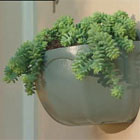The entrance to your house is very important. It should be welcoming, interesting and inviting. The owner of the house shown in our segment tried to make the front steps of her home look good, without success. She found it particularly hard to find plants that would tolerate the dry, hot conditions in full sun. Don brightened up the entrance with a few carefully chosen plants and pots, simple bits of theatre and some good taste.
How it was done
- The existing pot plants cluttered the steps, they looked ugly and Don was worried people might trip over the large pot on the top step. They all had to go!
- Don re-used a reconstituted sandstone urn on a plinth between the two sets of steps, to create a dramatic focal point. He gave the urn a rusty look by painting it with Porter’s Liquid Iron, followed by Porter’s Instant Rust.
- The urn was then planted with succulents: velvet elephant ear (Kalanchoe beharensis) in the centre, surrounded by jellybean plant (Sedum pachyphyllum). Most plants would struggle to survive in this type of urn, which has thick sides and not much room for potting mix. Succulents are ideal in this situation, because they store water in their thick, fleshy leaves and stems.
- For a subtle alternative to the traditional urn, Don painted a sandstone decorative pot to complement the lovely colours on the house. He wet the pot, then applied a coat of limewash (Porter’s Limewash ‘Old Church’).
- Next, some of the areas of detail were picked out in soft grey (Porter’s Limewash ‘Saltbush’) to give a rustic, shadowy look. When the paint was dry, the pot was planted with grassy liriopes (Liriope muscari ‘Monroe White’) and seaside daisies (Erigeron karvinskianus).
- A wall-mounted pot was painted to match the accent colours of the house, and planted with donkey’s tail (Sedum morganianum). This curious Mexican succulent has fleshy, bluish green, leaf-clad, rope-like stems up to 30cm (12″) long.
- Donkey’s tail makes an ideal hanging basket specimen for a hot, sunny position. It will thrive on neglect, even if you go on holidays or forget to water it for weeks at a time. The stems and leaves are very brittle and readily break off when touched. Broken pieces can be planted and will normally regrow.
- In a hanging pot near the front door, Don planted lace flower vine (Alsobia dianthiflora often sold as Episcia dianthiflora). This trailing plant has attractive, white frilled flowers.
Approximate prices
Pots
- Sandstone decorative pot (48cm x 48cm), $90
- Traditional urn goblet-style, $150
- Wall-mounted acrylic pot, $25
- Available from nurseries and pottery specialists
Paint
- Porter’s Limewash ‘Old Church’, $30 for 1 litre
- Porter’s Limewash ‘Saltbush’, $30 for 1 litre
- Porter’s Liquid Iron Rust, $50 for 1 litre
- Porter’s Instant Rust solution, $25 for 500ml
- Available from Porter’s Paints – www.porters.com.au
Plants
- Velvet elephant ear (Kalanchoe beharensis), $15 for 140mm (6″) pots
- Jellybean plant (Sedum pachyphyllum), $10 for 140mm (6″) pots
- Donkey’s tail or burro’s tail (Sedum morganianum), $15 for 140mm (6″) pots
- Liriope (Liriope muscari ‘Monroe White’), $15 for 140mm (6″) pots
- Seaside daisy (Erigeron karvinskianus), $15 for 140mm (6″) pots
- Lace flower vine (Alsobia dianthiflora often sold as Episcia dianthiflora), $10 for 140mm (6″) pots



